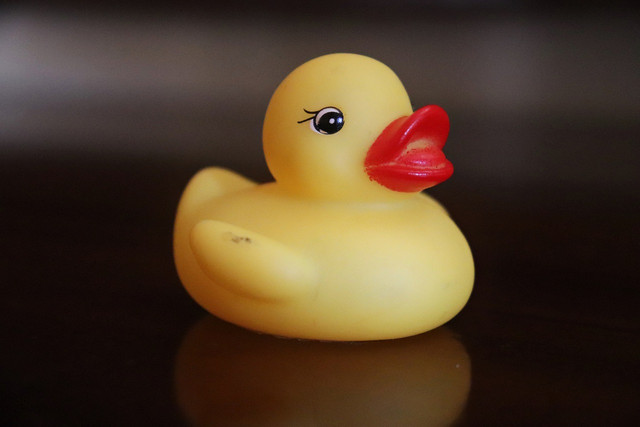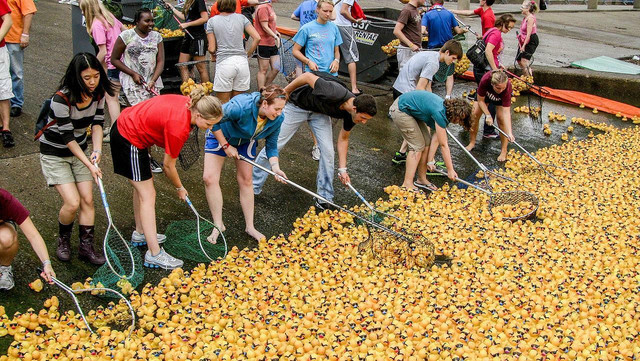A duck derby is when thousands of rubber ducks are released into a river and then race to a finish line. But are they good for nature as well as charity? Keep reading to find out.
Duck derbys are charity fundraising events where members of the public can sponsor a rubber duck to race down a river and the sponsorship money goes to local charities — the sponsor of the winning duck wins a prize. Each duck is numbered and the number is recorded alongside their sponsor’s details, it costs from five dollars to sponsor one duck (prices vary depending on each event/city).
The money raised from the duck sponsorship goes to local charities — thousands of dollars can be raised from these events, making them a vital source of income.
Each duck derby releases hundreds or thousands of plastic ducks into a river and they race using the natural flow of the river, like the game “Pooh sticks“. It’s a lot of fun to see the ducks bobbing along the river and to find out where they get stuck, participants can often get very competitive and excited to see if their duck wins — which will be decided entirely by chance.
Duck derbys are a fun day out for families and an interactive way to raise money for charity, but there can be an environmental cost. We’ll explain how these events can be organized with nature in mind, and look at if there are any greener alternatives.
Are Duck Derbys Harmful to Nature?

(Foto: CC0 / Pixabay / mufidpwt)
The number of ducks used in duck derbys depends on the size of the city and the river involved, for example at Chicago’s duck derby in 2019 more than 63,000 rubber ducks were poured into the Chicago River. However, smaller communities will run smaller duck races with fewer ducks.
These “rubber ducks” are not made of rubber, they are made from plastic and not all of them will make it to the finish line, some will get stuck or lost en route. If these rogue ducks are left in the river they will contribute to the plastic waste in the ecosystem.
Over time, plastics in water systems get damaged and broken up, but not broken down — they will never biodegrade completely. As a result, these damaged pieces, or microplastics (pieces of plastic smaller than 5 millimeters), remain in the ecosystem.
Microplastics are created due to photodegradation from the sun, its UV light helps oxygen atoms enter the polymer of the plastic which makes it more fragile and breakable. This doesn’t happen instantly, but takes time, as the plastic is exposed to the sun for longer periods.
Abrasion from wind and waves will assist in further fragmenting the size of the plastic — microplastics contribute to 85 percent of plastic pollution washed up on coastlines globally. Therefore the more often plastic ducks are used in duck races, the longer they are exposed to the sun and the elements, which will increase the release of microplastics from them.
It was previously believed that microplastics would quickly float from rivers and out to the sea. However, a recent study found that microplastics can accumulate in riverbeds as well. When microplastics are ingested by wildlife they can reduce the lifespan of that animal, affect reproduction or cause starvation — clearly a huge threat to all living things in water ecosystems.
What Happens After a Duck Derby? The Clean-Up



(Foto: CC0 / Pixabay / GregReese)
On a positive note, most duck derby organizers put in place several preventative actions to reduce the number of rubber ducks going astray: at the end of each race, a boom or net will be placed across the width of the river to catch the racing ducks. These are then removed by volunteers, who will also walk the length of the river to catch any trapped ducks — in a bigger river they may even use kayaks or small boats to retrieve harder-to-reach ducks. But it is still possible that some ducks get lost.
For annual duck derbys, the ducks are stored away to be used the following year or transported to another rubber duck race in another city. Due to the numerical system, it is also possible to know if any ducks are missing.
Alternatively, some duck derbys recycle their ducks, for example, after the Manchester duck race in the UK, the ducks are collected by a garbage recycling company that in the past has recycled the ducks into wheelie bins, pallets, and buckets.
Duck Derby Alternatives
There are some alternatives to traditional duck derbys. Due to Covid-19, derby organizers had to become more creative in order to avoid large crowds of people gathering together.
One idea in 2021 in the Aspen Highlands was to roll hundreds of rubber balls down a dry ski slope and catch them in a net at the end — so a more controlled derby and the likelihood of any runaway balls was very low. It was also streamed online, so sponsors didn’t have to attend, but could watch the action online.
Another alternative is a virtual duck derby. It is 100 percent online, participants have to log in to view where their duck is in the race over a period of a few days. Duck sponsors can often choose to decorate or name their ducks and add extra donations.
A final option is for a duck derby to take place on a man-made water course that doesn’t lead to a river and has no obstacles for ducks to get stuck in. This is usually done on a small scale, such as ducks being released into a swimming pool with a water pump providing the waves. To attract more participants it could also be streamed virtually, in a similar way to a virtual duck derby.
Read more:
- Environmental Organizations: 8 NGOs and Non-Profits Worth Supporting
- These 7 Suprising Items Release Microplastics into the Ocean
- 8 Things You Can Do to Save the Ocean
Do you like this post?







